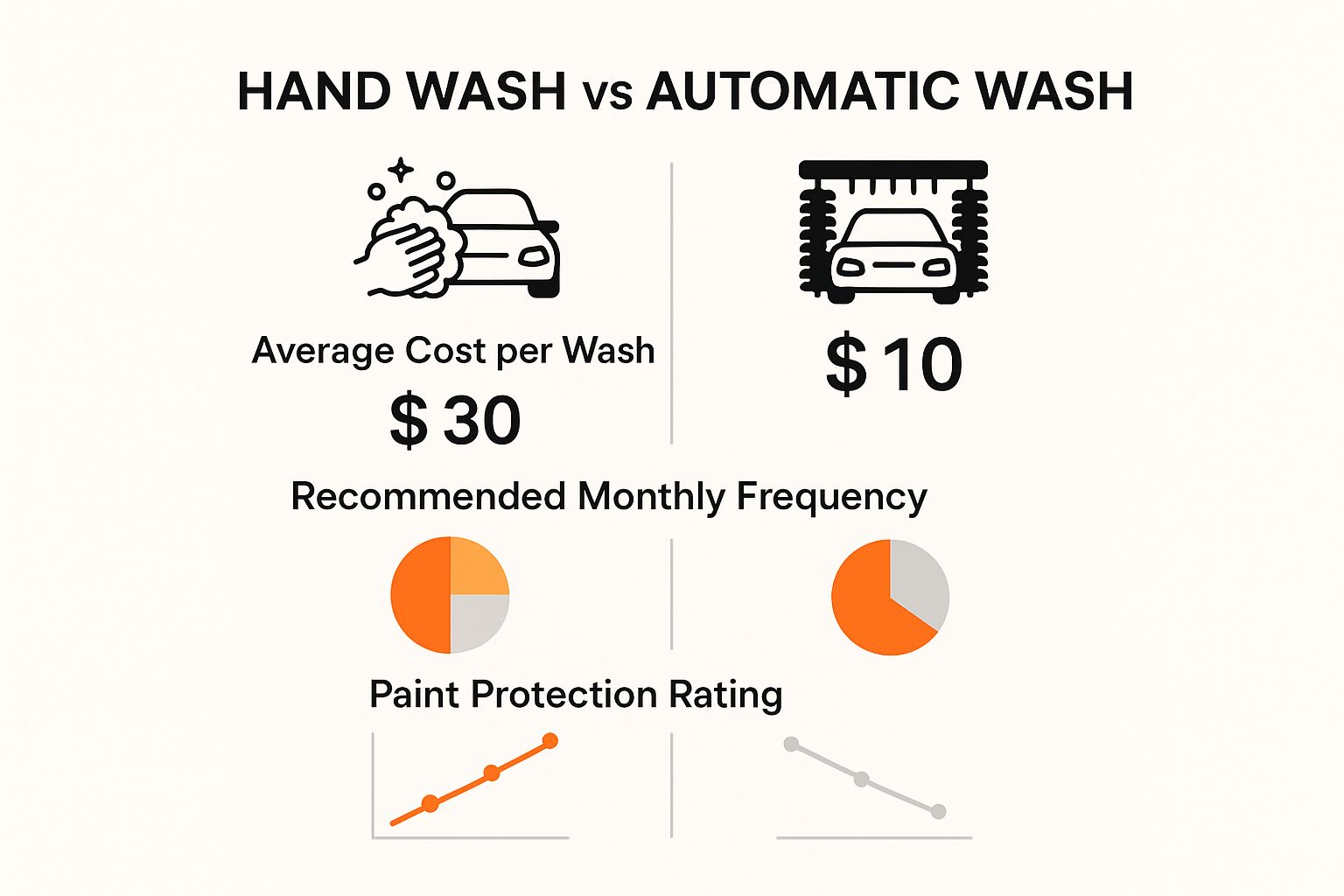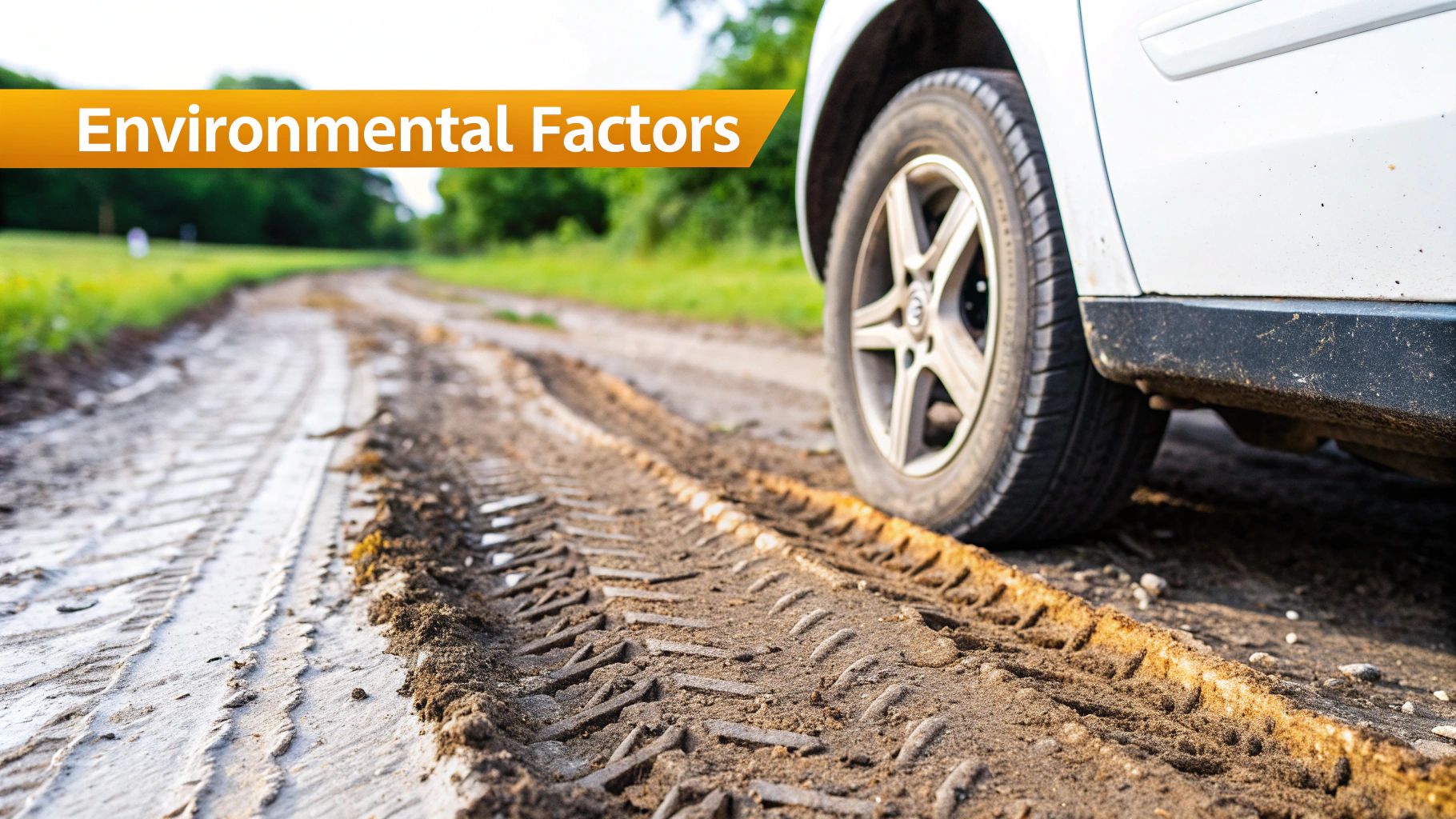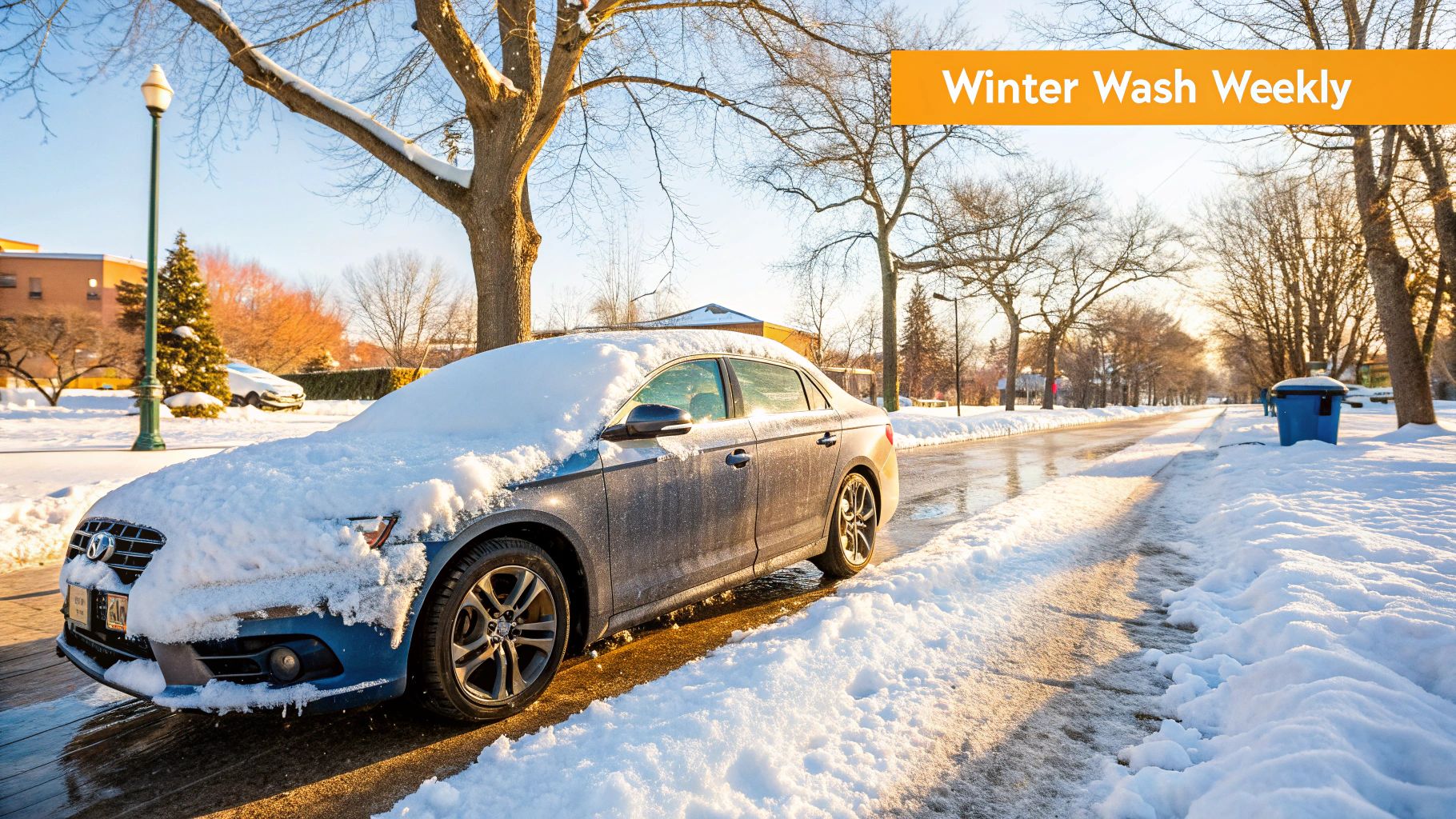Finding Your Perfect Car Washing Rhythm

This infographic compares hand washing and automatic washes. It examines factors like average cost per wash, recommended monthly frequency, and paint protection rating. While hand washing might offer slightly better paint protection, automatic washes provide a balance of cost-effectiveness and adequate protection for frequent cleaning. This highlights the importance of a routine that works for both your car and your wallet.
How often should you wash your car? The answer depends on a few things, but the general recommendation is around once or twice a month. This advice isn't random; it's based on how dirt and grime affect your car's finish. Regular washing prevents buildup, protecting your paint and maintaining your car's value.
Think of regular car washes like preventative maintenance. Just as regular checkups prevent small health issues from becoming serious problems, frequent washes stop dirt from causing lasting damage. Consistent upkeep, even if it's less intensive, is key to preserving your car's appearance and extending its lifespan.
A regular car wash routine offers more consistent protection than occasional deep cleans. While detailing is beneficial, it doesn’t replace the ongoing protection of regular washing. In the U.S., 66% of vehicle owners wash their cars once or twice a month, influenced by location, weather, and lifestyle. This shows a growing awareness of car maintenance and the convenience of modern car washes. Learn more about the car wash industry from Grand View Research.
Considering Your Options: Hand Washing vs. Automatic Washes
Choosing between hand washing and an automatic car wash involves balancing several factors. These include cost, convenience, and the level of protection desired. Hand washing is often praised for its meticulous approach, but it demands more time and specific products. Automatic washes, especially touchless ones, offer a fast and efficient alternative. Understanding the nuances of each method is crucial for making an informed choice.
To help illustrate the varying needs of different vehicles, let's take a look at the table below:
Recommended Car Washing Frequency by Vehicle Type
| Vehicle Type | Recommended Frequency | Key Considerations |
|---|---|---|
| Daily Commuter (City) | 1-2 times per week | Exposure to pollutants, road salt, and grime requires more frequent cleaning. |
| Weekend Car (Garage Kept) | 2 times per month | Less frequent exposure to elements means less frequent washing is necessary. |
| Off-Road Vehicles | After each off-road trip, then 1-2 times per month | Mud, dirt, and debris require immediate attention after off-roading. |
| Classic/Show Cars | Weekly, or before/after each show | Maintaining pristine condition is paramount for these vehicles. |
As the table shows, the recommended car washing frequency changes depending on how the vehicle is used and stored. A daily commuter exposed to city elements will benefit from more frequent washes, while a weekend car kept in a garage requires less attention.
For further tips on car washing, check out this article on the Best Time To Wash Car in 2025. Finding the right car washing rhythm balances practicality and effectiveness. By understanding what affects your car's cleaning needs, you can create a routine that keeps it looking its best while respecting your time and budget.
When Your Environment Calls The Shots

Where you live significantly impacts how often you should wash your car. Different climates and environments present unique challenges to your car’s finish, affecting how frequently you need to clean it. Understanding these factors is the first step toward establishing a tailored car washing schedule.
For instance, coastal areas expose your vehicle to salt-laden air which can accelerate corrosion. If you live near the ocean, you'll likely need to wash your car more often than someone residing inland.
Climate and Your Car's Cleanliness
Just as your skin requires different care in varying weather, so too does your car’s paint. Desert climates present challenges like dust and sand, which act like sandpaper and can scratch your paint. This might lead you to think you need to wash your car constantly.
However, finding a good balance is essential. Over-washing can also damage your car’s paint, so it's about finding the right frequency for your environment.
Winter brings another set of cleaning necessities. Road treatments, while vital for safe driving, leave behind salt and other chemicals that can damage your car’s undercarriage. Additionally, spring’s pollen can coat your car in a sticky film, potentially dulling the paint. Therefore, a more proactive washing schedule is advisable during these seasons.
Urban vs. Rural Environments: Different Dirt, Different Needs
Urban environments present unique car washing challenges. Air pollution and industrial fallout accumulate on your car’s surface, necessitating regular cleaning. But don’t think that rural areas get off scot-free.
Dirt roads and farmlands also contribute to grime build-up. Even where you park plays a role. Parking under trees, while providing shade, can expose your car to bird droppings and tree sap, both of which can damage the paint.
Tailoring Your Wash Schedule to Your Surroundings
To maintain your car’s appearance and protect its resale value, adapting your washing routine to your environment is key. The following table illustrates how various environmental conditions affect your car washing frequency.
To help you understand these impacts, we've compiled the information below:
Environmental Impact on Car Washing Needs
| Environmental Factor | Impact Level | Recommended Frequency Adjustment |
|---|---|---|
| Coastal Areas | High | Increase to 1-2 times per week, especially during winter. |
| Desert Climates | Moderate | Increase to every 2-3 weeks, focusing on thorough rinsing. |
| Urban Environments | Moderate | Increase to 2-3 times per month depending on pollution levels. |
| Rural Areas (Paved Roads) | Low | Maintain a standard bi-weekly schedule. |
| Areas with Frequent Road Salt Use | High | Increase to weekly washes during winter months. |
By understanding the environmental factors affecting your vehicle and adjusting your washing habits accordingly, you can keep your car looking its best regardless of location. For car wash products designed to tackle various environmental grime, consider checking out the products offered by SwiftJet.
Your Driving Style Determines Everything
Your driving style significantly impacts how often your car needs a wash. It's not just about the miles you drive, but also where and how you drive. Beyond essential safety practices, such as using your parking brake, your individual driving habits play a key role in determining your car's washing frequency.
Highway Driving vs. City Streets: Two Different Worlds
Daily highway driving exposes your car to a constant stream of bugs, road grime, and tar. This requires more frequent washing compared to city driving. Think of highways as a continuous dirt track, whereas city streets offer more intermittent exposure to dirt.
For instance, a car driven daily on the highway might need a wash every one to two weeks. A car primarily used for weekend city trips could easily go two to three weeks between washes. This is a general guideline, not a strict rule, as actual conditions may vary.
Off-Roading and Adventures: A Special Case
Off-roading presents unique cleaning challenges. Mud, dust, and debris accumulate rapidly, demanding immediate attention after each adventure. This is crucial not only for aesthetics but also to prevent damage from caked-on mud.
Even off-road vehicles benefit from regular maintenance washes beyond post-adventure cleaning. A monthly wash helps protect the paint from long-term damage, even for the most adventurous drivers.
Parking Habits and Their Impact
Your parking habits also influence how often you should wash your car. Parking in a garage shields your vehicle from the elements, allowing for longer intervals between washes. Conversely, parking outside, particularly under trees, exposes your car to bird droppings, tree sap, and pollen, necessitating more frequent cleaning.
Consider your own parking habits. Do you park outside daily? Do you live in an area with a lot of birds? These factors should be considered when deciding how often to wash your car.
Professional Vs. DIY: The Great Washing Debate

There's a noticeable shift in how people are washing their cars. Many car owners are moving away from the do-it-yourself method and opting for professional car wash services. This trend begs the question: why the change? Is it purely convenience, or are other factors contributing to this shift? Understanding these trends can help you develop the best car care strategy for your needs.
Over the past few decades, car washing preferences have dramatically changed. In 1996, 52% of consumers primarily washed their cars at home. By 2023, that number dropped significantly, with 89% of car owners now preferring professional services.
This shift is largely attributed to the convenience and increasing availability of eco-friendly options. Professional car washes, particularly in-bay automatics, are known for their speed and water conservation efforts. For a deeper dive into these trends, check out this resource: Car Wash Industry Trends.
Cost-Effectiveness: Weighing Your Options
While the initial cost of a professional wash might seem higher, it's essential to consider the hidden costs of DIY car washing. Buying cleaning supplies, water usage, and the time commitment can quickly add up.
Professional washes often offer various package deals and memberships. These options can make professional washing a surprisingly budget-friendly choice over the long term. Furthermore, professional services often use specialized equipment and cleaning solutions not readily available to consumers.
This results in a superior clean, protecting your car's finish and potentially saving you money on future detailing or repairs. For those interested in professional-grade equipment, you might find this article helpful: Top Car Washer Spray Gun Picks for a Perfect Clean.
Time Investment: Making the Most of Your Minutes
Perhaps the most significant advantage of professional car washing is the time saved. Washing your car yourself can easily consume an hour or more. A professional wash, however, is often completed in just minutes, freeing up your time for other important tasks.
DIY car washing still has its place. Car enthusiasts who enjoy the process and find satisfaction in meticulously caring for their vehicles often prefer this method. This hands-on approach offers greater control and can be a therapeutic activity for some. Both DIY and professional washing offer their own unique benefits.
Quality of Clean: Professional Expertise vs. DIY Effort
Professional car washes frequently use advanced equipment, including high-pressure sprayers and specialized brushes. This equipment ensures a deep clean that's difficult to achieve at home, effectively removing stubborn dirt and grime.
Professional detailers also possess the knowledge to identify and address specific cleaning needs. Whether it's removing tree sap or treating water spots, their expertise helps maintain your car's appearance and value.
The best choice between professional and DIY car washing ultimately depends on your individual preferences, budget, and desired outcomes. Both approaches offer distinct advantages. Choosing the right one ensures your car receives the care it deserves.
What Industry Growth Means For Your Car
The car care industry is experiencing significant growth, a trend that offers numerous benefits for car owners. This expansion isn't simply about an increase in the number of businesses; it's about more choices, improved service quality, and better value. Increased competition among car wash providers fosters innovation and higher standards, ultimately benefiting you and your vehicle.
Leveraging the Expanding Market to Your Advantage
This growth is a catalyst for advancements in car care technology and services. Consider the rise of eco-friendly washes, convenient subscription models, and mobile detailing services that come directly to you. These innovative options make car maintenance more accessible and effective. For example, many car washes have adopted water reclamation systems, minimizing environmental impact while ensuring a thorough clean.
The increasing demand for specialized services, such as ceramic coatings and paint correction, has also led to a wider availability of these advanced options. This gives you greater access to high-quality services that can significantly enhance the lifespan and value of your car. Market growth allows you to be more discerning, finding services that perfectly match your needs and budget.
The global car wash and detailing market is projected to reach $54.98 billion by 2029, expanding at a CAGR of 5.84%. This impressive growth is driven by rising vehicle ownership, urbanization, and a higher demand for professional car care. The U.S. holds a significant position in this market, contributing over 43% of the global car wash industry revenue. You can learn more about this at Car Wash Global Market.
Making Informed Choices in a Competitive Landscape
Understanding these industry trends helps you make smarter decisions about car washing frequency and service providers. With a wider array of choices, it's crucial to evaluate providers based on factors such as pricing, services offered, and customer reviews. Don't hesitate to compare different options before settling on a specific car wash.
This competitive environment also empowers you to negotiate better deals and find services that fit your budget. Many providers offer discounts for multiple washes or subscription packages. Taking advantage of these deals helps you maintain a regular washing schedule without overspending. By staying informed about industry developments, you can use these changes to keep your car in excellent condition and maximize the value of your car care spending.
Red Flags That Demand Immediate Action

Even with a regular car washing routine, certain situations call for immediate attention. Knowing these "red flags" can save you from costly repairs down the road. This involves understanding the difference between everyday dirt and truly harmful contaminants. For tips on making your car care content more visible online, check out these SEO Tips for Bloggers.
Identifying Harmful Contaminants
Some substances can seriously damage your car's paint if not removed quickly.
-
Road Salt: Especially damaging in winter, road salt accelerates the corrosion process and can harm your car's undercarriage. Washing your car immediately is important, even if it doesn't look particularly dirty.
-
Tree Sap: This sticky residue can etch into your car's paint. Prompt removal is essential. The longer it sits, the harder it becomes to clean effectively.
-
Bird Droppings: Bird droppings are highly acidic and can quickly damage your car's clear coat and paint. Act fast to minimize the impact.
-
Bug Splatter: While seemingly harmless, bug remains are acidic. Over time, they can etch the paint. Prompt cleaning is a good preventative measure.
Assessing Your Car's Condition
Beyond specific contaminants, other signs indicate your car needs a wash.
-
Reduced Visibility: Grime on your windows and mirrors can significantly reduce visibility, creating a safety hazard. Prioritize cleaning these areas.
-
Thick Layers of Dirt or Grime: If dirt is obscuring your car's color, it's definitely time for a wash. This buildup traps moisture against the paint, encouraging corrosion.
-
Compromised Protective Coatings: If your car has a wax or sealant, heavy dirt can reduce its effectiveness. Washing helps restore this protective layer.
Emergency Response Strategies
Dealing with these red flags requires more than a quick rinse.
-
Thorough Rinsing: Rinse your car thoroughly before washing to remove loose debris and prevent scratching.
-
Appropriate Cleaning Solutions: Use a car wash soap designed for cars. Avoid household detergents, as these can strip wax and damage the paint.
-
Focus on Problem Areas: Pay close attention to areas affected by harmful contaminants. A dedicated cleaner may be necessary.
-
Post-Wash Protection: Consider applying a fresh coat of wax or sealant after washing to restore protection.
By recognizing these red flags and taking prompt action, you can protect your car’s finish, maintain its value, and prevent costly repairs. This proactive approach, combined with your regular washing schedule, ensures your car stays clean no matter what.
Building Your Personal Washing Blueprint
Creating a personalized car washing plan is all about finding the right balance between optimal car care and your lifestyle. Think of it like a personalized fitness plan: you wouldn't follow the same routine as a professional athlete if you're just starting to exercise. Your car wash schedule should be just as tailored to your specific needs.
Assessing Your Unique Situation
Before establishing a routine, take a moment to assess your car’s specific needs. Just as a doctor considers your medical history before recommending treatment, you need to evaluate the factors that affect your car's cleanliness.
-
Environment: Do you live in a coastal area with salt air or a desert region with frequent dust storms? These environmental conditions significantly impact how often you should wash your car.
-
Driving Habits: Are you a daily commuter battling highway grime or a weekend driver enjoying leisurely trips? Do you frequently drive on unpaved roads or stick to paved highways? Your driving habits play a major role in how quickly your car accumulates dirt.
-
Personal Preferences: How important is a spotless car to you? Are you willing to dedicate the time and resources for regular washes, or do you prefer a more low-maintenance approach?
Creating a Sustainable Schedule
Once you've considered your specific circumstances, you can create a car washing schedule that you can actually stick to. A good starting point is washing your car every two weeks. Adjust this baseline frequency based on your individual assessment.
-
High-Impact Environments: If you live near the coast or in a dusty area, you might want to wash your car weekly or every other week.
-
Frequent Drivers: Daily commuters, particularly those on highways, should consider weekly washes to combat the build-up of road grime.
-
Weekend Warriors: If you use your car less often, you can likely extend the time between washes to three or even four weeks. For tips on a perfect wash, check out this article: How to master a scratch-free car wash.
Tracking and Adjusting Your Plan
Just like any good plan, your car washing schedule should be adaptable. Keep an eye on your car's cleanliness and modify your schedule as needed. If you notice your car getting dirty faster than usual, simply increase the washing frequency.
Use a calendar or a reminder app to keep track of your washes and maintain a consistent routine. This helps you stay on top of your car’s care and avoid neglecting its cleanliness. Regular washing is more effective than occasional deep cleans, protecting your car's finish and helping maintain its value over time.
Ready for a Professional-Grade Clean at Home?
The SwiftJet Car Wash Foam Gun provides a powerful and efficient way to keep your car sparkling without constant trips to the car wash. Its thick foam clings to the car's surface, lifting away dirt and grime for an easier and faster wash. Check out SwiftJet today to discover the difference.
